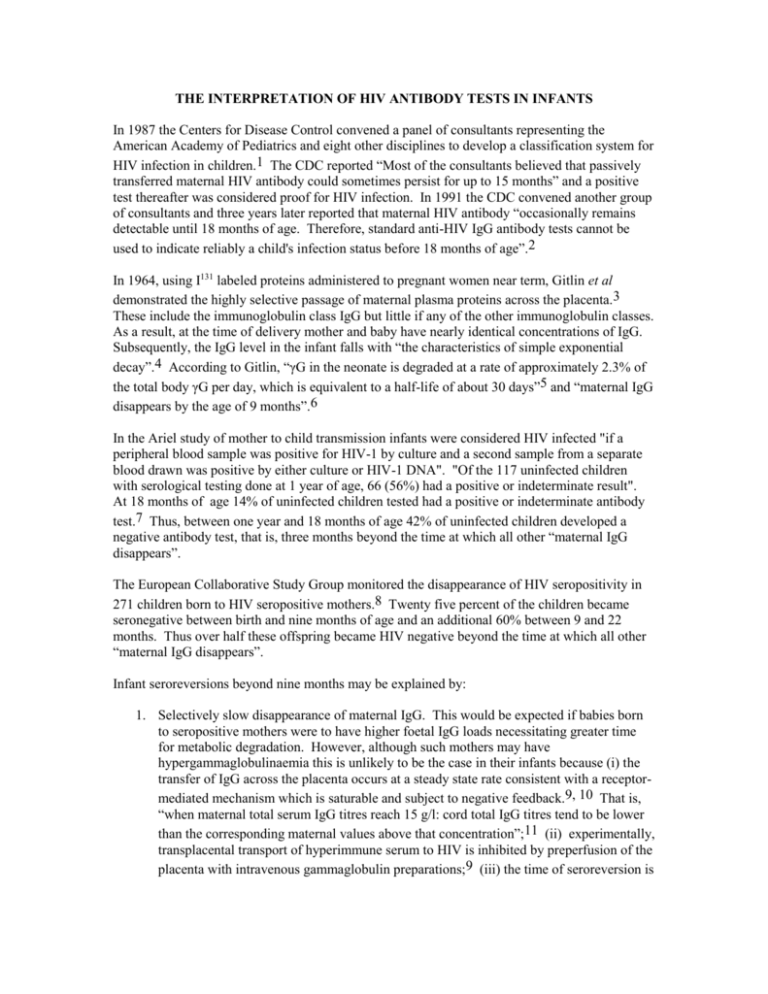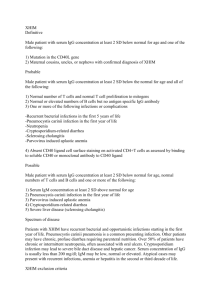references - David Crowe
advertisement

THE INTERPRETATION OF HIV ANTIBODY TESTS IN INFANTS In 1987 the Centers for Disease Control convened a panel of consultants representing the American Academy of Pediatrics and eight other disciplines to develop a classification system for HIV infection in children.1 The CDC reported “Most of the consultants believed that passively transferred maternal HIV antibody could sometimes persist for up to 15 months” and a positive test thereafter was considered proof for HIV infection. In 1991 the CDC convened another group of consultants and three years later reported that maternal HIV antibody “occasionally remains detectable until 18 months of age. Therefore, standard anti-HIV IgG antibody tests cannot be used to indicate reliably a child's infection status before 18 months of age”.2 In 1964, using I131 labeled proteins administered to pregnant women near term, Gitlin et al demonstrated the highly selective passage of maternal plasma proteins across the placenta.3 These include the immunoglobulin class IgG but little if any of the other immunoglobulin classes. As a result, at the time of delivery mother and baby have nearly identical concentrations of IgG. Subsequently, the IgG level in the infant falls with “the characteristics of simple exponential decay”.4 According to Gitlin, “γG in the neonate is degraded at a rate of approximately 2.3% of the total body γG per day, which is equivalent to a half-life of about 30 days”5 and “maternal IgG disappears by the age of 9 months”.6 In the Ariel study of mother to child transmission infants were considered HIV infected "if a peripheral blood sample was positive for HIV-1 by culture and a second sample from a separate blood drawn was positive by either culture or HIV-1 DNA". "Of the 117 uninfected children with serological testing done at 1 year of age, 66 (56%) had a positive or indeterminate result". At 18 months of age 14% of uninfected children tested had a positive or indeterminate antibody test.7 Thus, between one year and 18 months of age 42% of uninfected children developed a negative antibody test, that is, three months beyond the time at which all other “maternal IgG disappears”. The European Collaborative Study Group monitored the disappearance of HIV seropositivity in 271 children born to HIV seropositive mothers.8 Twenty five percent of the children became seronegative between birth and nine months of age and an additional 60% between 9 and 22 months. Thus over half these offspring became HIV negative beyond the time at which all other “maternal IgG disappears”. Infant seroreversions beyond nine months may be explained by: 1. Selectively slow disappearance of maternal IgG. This would be expected if babies born to seropositive mothers were to have higher foetal IgG loads necessitating greater time for metabolic degradation. However, although such mothers may have hypergammaglobulinaemia this is unlikely to be the case in their infants because (i) the transfer of IgG across the placenta occurs at a steady state rate consistent with a receptormediated mechanism which is saturable and subject to negative feedback.9, 10 That is, “when maternal total serum IgG titres reach 15 g/l: cord total IgG titres tend to be lower than the corresponding maternal values above that concentration”;11 (ii) experimentally, transplacental transport of hyperimmune serum to HIV is inhibited by preperfusion of the placenta with intravenous gammaglobulin preparations;9 (iii) the time of seroreversion is unrelated to maternal or neonatal IgG concentrations;12 (iv) the half life of IgG in children aged 6 months to 8 years is 20 days compared to 30 days in the newborn.13 Moreover, there are ample data illustrating the opposite is true,14, 15 that is, HIV seropositive mothers transfer less IgG to their infants. “Both maternal hypergammaglobulinaemia and maternal HIV infection may contribute to these low antibody levels at birth and thus lead to early infection in this high-risk population”.15 This is greatly exacerbated by placental malaria infection,11 prematurity and low birth weight,16-20 factors likely to operate where mother-to-child transmission is considered prevalent. For example, “Babies born before 22 weeks have severe agammaglobulinaemia and those born before 34 weeks’ gestation may be expected to develop agammaglobulinaemia within the first two months of life”.21 Such circumstances will lead to disappearance of maternal IgG well before 9 months of age. 2. Selectively slower decline in maternal HIV IgG relative to total IgG. However, researchers from the CDC have “calculated that the half-life of the maternal anti-HIV-1 IgG antibodies is 28-30 days” and that it decays “to background levels by 6 months”,22 that is, at a rate at least as high as total IgG. 3. Maternal HIV IgA obtained via breastfeeding. Given that in the Ariel study no mother breastfed and in the European Collaborative Study “5% [of infants] were breastfed for periods from 1 to 30 weeks (median 2.5))”,23 this appears extremely improbable. Also, if breastmilk IgA were the explanation one would predict no seroreversions before weaning and all seroreversions after 9 months related to the time of weaning. We have been unable to find data to test this hypothesis. Since the these alternatives are either doubtful or unsupported by data it is necessary to consider two other explanations: (a) infants who serorevert beyond six to nine months of age generate and subsequently lose their own HIV antibodies. This implies that by unknown means and without specific antiretroviral treatment at least 60% of infants successfully eliminate HIV; (b) in at least 60% of infants a positive antibody test is caused by non-HIV antibodies. That is, the detection of such antibodies is unrelated to HIV infection. If 25% of children test positive between birth and nine months because of maternal antibodies and in 60% the test is non-specific, how certain can one be that in the remaining 15% of children the test will not also eventually serorevert? Or if the test remains positive it is a true positive?24-27 Eleni Papadopulos-Eleopulos Biophysicist Department of Medical Physics, Royal Perth Hospital, Perth, Western Australia 6847 Valendar F. Turner Consultant Emergency Physician Department of Emergency Medicine, Royal Perth Hospital, Perth, Western Australia 6847 John M Papadimitriou Professor of Pathology University of Western Australia, Perth, Western Australia 6907 Helman Alfonso Department of Research, Universidad Metropolitana Barranquilla, Colombia Barry A. P. Page Physicist, Department of Medical Physics, Royal Perth Hospital, Perth, Western Australia 6847 David Causer Physicist Department of Medical Physics, Royal Perth Hospital, Perth, Western Australia 6847 Sam Mhlongo Head & Chief Family Practitioner, Family Medicine & Primary Health Care Medical University of South Africa, 0204, South Africa Todd Miller Assistant Scientist, Department of Molecular and Cellular Pharmacology University of Miami School of Medicine, Florida, 33124 United States of America Christian Fiala Department of Obstetrics and Gynaecology Mulago Hospital, Makarere University, PO Box 7072, Kampala. Anthony Brink Advocate of the High Court of South Africa Blue Lagoon Hotel, P O Box 2177 Beacon Bay, 5241 South Africa. Neville Hodgkinson Science Writer Nuneham Park, Oxford, England OX44 9PG Manu Kothari Professor of Anatomy Seth Gordhandas Sunderdas Medical College, King Edward Memorial Hospital, Mumbai, India. David Crowe President Alberta Reappraising AIDS Society Box 61037, Kensington PO, Calgary, Alberta, Canada T2N 4S6. REFERENCES 1. CDC. Current Trends Classification System for Human Immunodeficiency Virus (HIV) Infection in Children Under 13 Years of Age. Morb Mortal Wkly Rep 1987;36:225-30, 235-6. 2. CDC. 1994 Revised Classification System for Human Immunodeficiency Virus Infection in Children Less Than 13 Years of Age. Morb Mortal Wkly Rep 1994;43 (RR-12):1-10. 3. Gitlin D, Kumate J, Urrusti H, Morales C. The selectivity of the human placenta in the transfer of plasma proteins from mother to fetus. J Clin Invest 1964;43:1938-1951. 4. Orlandini T, Sass-Kortsak A, Ebbs JH. Serum gamma globulin levels in normal infants. Pediatrics 1955;16:575-583. 5. Gitlin D. Development and metabolism of the immune globulins. In: Kagan BM, Stiehm ER, editors. Immunologic incompetence. Chicago: Year Book Publishers; 1971. p. 3-13. 6. Stiehm ER. Immunologic diseases in infants and children. 3rd ed. Philadelphia: WB Saunders Company; 1973. 7. Van Dyke RB, Korber BT, Popek E, Macken C, Widmayer SM, Bardeguez A, et al. The Ariel Project: A prospective cohort study of maternal-child transmission of human immunodeficiency virus type 1 in the era of maternal antiretroviral therapy. J Infect Dis 1999;179:319-28. 8. Mother-to-child transmission of HIV infection. The European Collaborative Study. Lancet 1988;ii:1039-43. 9. Landor M, Rubinstein A, Kim A, Calvelli T, Mizrachi Y. Receptor-mediated maternofetal transfer of immunoglobulins. Inhibition of transport of anti-HIV-1 immunoglobulin by generic immunoglobulins in the in vitro perfused placenta. Int Arch Allergy Immunol 1998;115:203-9. 10. Eaton BM, Oakey MP. Image analysis of protein profiles from paired microvillous and basal syncytiotrophoblast plasma membranes from term human placenta and characterization of IgG binding to membrane vesicles. Placenta 1997;18:569-76. 11. de Moraes-Pinto MI, Verhoeff F, Chimsuku L, Milligan PJ, Wesumperuma L, Broadhead RL, et al. Placental antibody transfer: influence of maternal HIV infection and placental malaria. Arch Dis Child Fetal Neonatal Ed 1998;79:F202-5. 12. Chantry CJ, Cooper ER, Pelton SI, Zorilla C, Hillyer GV, Diaz C. Seroreversion in human immunodeficiency virus-exposed but uninfected infants. Pediatr Infect Dis J 1995;14:382-7. 13. Dixon FJ, Talmage DW, Maurer PH, Deichmiller M. The half-life of homolgous gamma globulin (antibody) in several species. J Exp Med 1952;96:313-318. 14. de Moraes-Pinto MI, Farhat CK, Carbonare SB, Curti SP, Otsubo ME, Lazarotti DS, et al. Maternally acquired immunity in newborns from women infected by the human immunodeficiency virus. Acta Paediatr 1993;82:1034-8. 15. de Moraes-Pinto MI, Almeida AC, Kenj G, Filgueiras TE, Tobias W, Santos AM, et al. Placental transfer and maternally acquired neonatal IgG immunity in human immunodeficiency virus infection. J Infect Dis 1996;173:1077-84. 16. Okoko JB, Wesumperuma HL, Hart CA. The influence of prematurity and low birthweight on transplacental antibody transfer in a rural West African population. Trop Med Int Health 2001;6:529-34. 17. Okoko BJ, Wesumperuma LH, Hart AC. Materno-foetal transfer of H. influenzae and pneumococcal antibodies is influenced by prematurity and low birth weight: implications for conjugate vaccine trials. Vaccine 2001;20:647-50. 18. Okoko BJ, Wesuperuma LH, Ota MO, Banya WA, Pinder M, Gomez FS, et al. Influence of placental malaria infection and maternal hypergammaglobulinaemia on materno-foetal transfer of measles and tetanus antibodies in a rural west African population. J health, popul nutr 2001;19:59-65. 19. Okoko BJ, Wesumperuma LH, Ota MO, Pinder M, Banya W, Gomez SF, et al. The influence of placental malaria infection and maternal hypergammaglobulinemia on transplacental transfer of antibodies and IgG subclasses in a rural West African population. J Infect Dis 2001;184:627-32. 20. Hartter HK, Oyedele OI, Dietz K, Kreis S, Hoffman JP, Muller CP. Placental transfer and decay of maternally acquired antimeasles antibodies in Nigerian children. Ped Infect Dis J 2000;19:635-41. 21. Riches PG, Hobbs JR. Mechanisms in secondary hypogammaglobulinaemia. J Clin Pathol. Suppl (Royal College of Pathologists). 1979;13:15-32. 22. Parekh BS, Shaffer N, Coughlin R, Hung CH, Krasinski K, Abrams E, et al. Dynamics of maternal IgG antibody decay and HIV-specific antibody synthesis in infants born to seropositive mothers. The NYC Perinatal HIV Transmission Study Group. AIDS Res Hum Retroviruses 1993;9:907-12. 23. European Collaborative Study Group. Children born to women with HIV-1 infection: natural history and risk of transmission. Lancet 1991;337:253-260. 24. Papadopulos-Eleopulos E, Turner VF, Papadimitriou JM. Is a positive Western blot proof of HIV infection? Bio/Technology 1993;11:696-707. 25. Papadopulos-Eleopulos E, Turner VF, Papadimitriou JM, Causer D, Page B. HIV antibody tests and viral load - more unanswered questions and a further plea for clarification. Curr Med Res Opin 1998;14:185-186. 26. Papadopulos-Eleopulos E, Turner VF, Papadimitriou JM, Causer D. HIV antibodies: Further questions and a plea for clarification. Curr Med Res Opin 1997;13:627-634. 27. Papadopulos-Eleopulos E, Turner VF, Papadimitriou JM, Alfonso H, Page BAP, Causer D, et al. Mother to Child Transmission of HIV and its Prevention with ATZ and Nevirapine. Perth: The Perth Group; 2001. http://www.aidspanelreport.com/newperthpaper.htm






